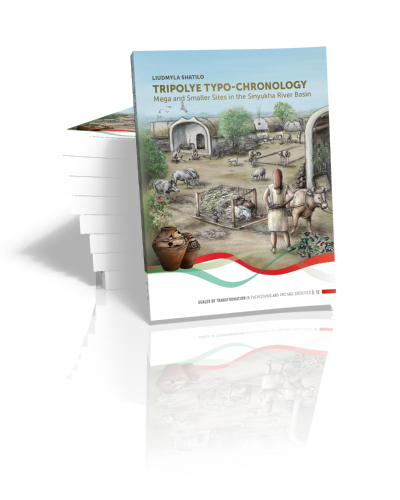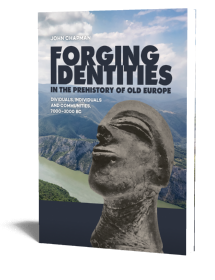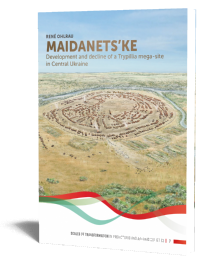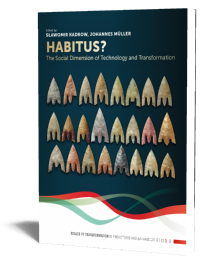Tripolye Typo-chronology
Mega and Smaller Sites in the Sinyukha River Basin
Liudmyla Shatilo | 2021

Tripolye Typo-chronology
Mega and Smaller Sites in the Sinyukha River Basin
Liudmyla Shatilo | 2021
Paperback ISBN: 9789088909511 | Hardback ISBN: 9789088909528 | Imprint: Sidestone Press Dissertations | Format: 210x280mm | 422 pp. | Scales of Transformation 12 | Series: Scales of Transformation | Language: English | 100 illus. (bw) | 90 illus. (fc) | Keywords: Prehistoric archaeology; Tripolye; chronology; mega-sites; Sinyukha River Basin; pottery; carbon dating; typochronology; Eastern Europe | download cover | DOI: 10.59641/m5457py
Read online or downloaded 5344 times
-
Digital & Online access
This is a full Open Access publication, click below to buy in print, browse, or download for free.
-
Buy via Sidestone (EU & UK)
-
Buy via our Distributors (WORLD)
For non-EU or UK destinations you can buy our books via our international distributors. Although prices may vary this will ensure speedy delivery and reduction in shipping costs or import tax. But you can also order with us directly via the module above.
UK international distributor
USA international distributor
-
Bookinfo
Paperback ISBN: 9789088909511 | Hardback ISBN: 9789088909528 | Imprint: Sidestone Press Dissertations | Format: 210x280mm | 422 pp. | Scales of Transformation 12 | Series: Scales of Transformation | Language: English | 100 illus. (bw) | 90 illus. (fc) | Keywords: Prehistoric archaeology; Tripolye; chronology; mega-sites; Sinyukha River Basin; pottery; carbon dating; typochronology; Eastern Europe | download cover | DOI: 10.59641/m5457py
Read online or downloaded 5344 times

We will plant a tree for each order containing a paperback or hardback book via OneTreePlanted.org.
The Tripolye phenomenon, which displays a specific artefact complex and an extraordinary settlement layout, is also known for its so-called ‘mega sites’. Five of the largest ‘mega’ or giant settlements measure between 150-320 ha in size. These, and other big settlements, are concentrated in the Sinyukha River Basin, which is a central part of modern Ukraine. In this region, more than 100 different Tripolye sites are known.
The chronology of this region is the key to understanding not only the ‘mega-site’ phenomenon, but also the dynamics of spatial development within the Tripolye phenomenon in general. The central issue of this study focusses on the reconstruction of the Tripolye chronology in the Sinyukha Basin and its surrounding areas, including the chronology of individual mega-sites, the periodization of spatial Tripolye distribution, the development of ceramic styles, the lifetime of individual sites, and Tripolye settlements in time and space. Special attention is paid to the ceramics as one of the main sources for typo-chronologies. The obtained results provide a new view on the appearance, functions and the end of Tripolye, in general, and of large sites in particular.
Preface
Introduction
1. Relative Chronology of Tripolye: Research History and State of the Art
1.1. Early typological models
1.2. Passek’s general periodization of Tripolye
1. 2. 1. Passek’s contribution
1. 2. 2. Tripolye ABC: Passek’s general chronological scale
1. 3. Typo-chronological alterations to Passek’s periodization
1. 3. 1. Chronology and spatial diversity: Chernysh approach
1. 4. From monolithic Tripolye to a series of local-chronological groups
1. 4. 1. Zakharuk’s framework: Ethnicity and material culture
1.4.2. Tripolye: Zakharuk’s model
1. 4. 3. Developing a method of singling out local variants
1. 4. 4. “Eastern” Tripolye
1. 4. 5. “Western” Tripolye
1. 5. Conclusions
1. 6. Research gaps and future tasks
2. Introduction to the mega-site region, research questions, sources
2.1. Research questions
2.2. Definition of the study region
2.3. Geography of the study region
2.3.1. Tectonics
2.3.2. Relief
2.3.3. Hydrology
2.3.4. Soils
2.3.5. Vegetation
2.3.6. Climate
2.4. Previous relative chronology of Tripolye sites
2.5. Sources for chronological constructions
2.5.1. Sites of the region
2.5.2. Pottery
2.5.3. Radiocarbon dates
2.6. Research methods
2.6.1. Pottery analysis
2.6.2. Modelling of 14C dates
2.6.3. Analysis of settlement patterns
3. Chronology on the local scale: the case of Talianki
3.1. General information
3.1.1. Discovery and excavations
3.1.2. Archaeo-magnetic plans
3.1.3. Topography
3.2 Research questions
3.3. Data base
3.3.1. The archaeo-magnetic plan
3.3.2. Excavations
3.4. Models of formation and development
3.5. 14C dates of Talianki
3.5.1. Testing models by sum-calibrations
3.5.2. Calculating dating probabilities of individual house areas
3.6. Talianki pottery
3.6.1. Methodological remarks
3.6.2. Testing Ryzhov’s typology
3.6.3. Ceramic typology
3.6.4. Analyses of pottery
3.7. Interpretation of 14C dates and pottery analysis
3.8. Discussion: intra-site chronology of Talianki
4. Chronology on the regional scale: sites of the Sinyukha River Basin
4.1. Key sites: selection and overview
4.2. 14C dates from the Sinyukha region
4.2.1. The selection of samples
4.2.2. The analyses of the 14C samples per site
4.2.3. Methodological remarks
4.2.4. The sequence of key sites
4.3. Regional analyses of pottery
4.3.1. The data base
4.3.2. Technology: Kitchenware versus other ware
4.3.3. Vessels’ morphology
4.3.4. Capacity
4.4. Interpretation and conclusions: Tripolye development
5. Tripolye mega and smaller sites of the Sinyukha River Basin
5.1. Commonly discussed narratives on the history of giant settlements
5.2. Mega-site definition
5.3. Duration of site lifetime
5.4. Structural changes
5.5. Tripolye sites in time and space
Conclusions
Afterword: view on the Tripolye site (cover description)
Zusammenfassung
Резюме
References
Appendixes

Dr. Liudmyla Shatilo
From 2006-2010, Liudmyla Shatilo attended the Taras Shevchenko National University of Kyiv and completed her Bachelor’s degree in History at the Department of Ancient World and Middle Ages, Historical Faculty. She continued her studies at the National University of “Kyiv-Mohyla Academy”, where she was awarded her Master’s degree in History with a major in Archaeology in 2012. From 2012-2015, she continued her research at the Institute of Archaeology of the National Academy of Sciences, Department of Eneolithic and Bronze Age Archaeology where she received the degree of kandidat istorichnih nauk in September 2017. From 2016-2019, she expanded on her research as a PhD student at the Institute of Pre- and Protohistoric Archaeology, Kiel University in the CRC 1266 ‘Scales of Transformation – Human-Environmental Interaction in Prehistoric and Archaic Societies’ within the subproject ‘Population agglomeration at Tripolye-Cucuteni mega-sites’. She was awarded her PhD in April 2020.
Abstract:
The Tripolye phenomenon, which displays a specific artefact complex and an extraordinary settlement layout, is also known for its so-called ‘mega sites’. Five of the largest ‘mega’ or giant settlements measure between 150-320 ha in size. These, and other big settlements, are concentrated in the Sinyukha River Basin, which is a central part of modern Ukraine. In this region, more than 100 different Tripolye sites are known.
The chronology of this region is the key to understanding not only the ‘mega-site’ phenomenon, but also the dynamics of spatial development within the Tripolye phenomenon in general. The central issue of this study focusses on the reconstruction of the Tripolye chronology in the Sinyukha Basin and its surrounding areas, including the chronology of individual mega-sites, the periodization of spatial Tripolye distribution, the development of ceramic styles, the lifetime of individual sites, and Tripolye settlements in time and space. Special attention is paid to the ceramics as one of the main sources for typo-chronologies. The obtained results provide a new view on the appearance, functions and the end of Tripolye, in general, and of large sites in particular.
Contents
Preface
Introduction
1. Relative Chronology of Tripolye: Research History and State of the Art
1.1. Early typological models
1.2. Passek’s general periodization of Tripolye
1. 2. 1. Passek’s contribution
1. 2. 2. Tripolye ABC: Passek’s general chronological scale
1. 3. Typo-chronological alterations to Passek’s periodization
1. 3. 1. Chronology and spatial diversity: Chernysh approach
1. 4. From monolithic Tripolye to a series of local-chronological groups
1. 4. 1. Zakharuk’s framework: Ethnicity and material culture
1.4.2. Tripolye: Zakharuk’s model
1. 4. 3. Developing a method of singling out local variants
1. 4. 4. “Eastern” Tripolye
1. 4. 5. “Western” Tripolye
1. 5. Conclusions
1. 6. Research gaps and future tasks
2. Introduction to the mega-site region, research questions, sources
2.1. Research questions
2.2. Definition of the study region
2.3. Geography of the study region
2.3.1. Tectonics
2.3.2. Relief
2.3.3. Hydrology
2.3.4. Soils
2.3.5. Vegetation
2.3.6. Climate
2.4. Previous relative chronology of Tripolye sites
2.5. Sources for chronological constructions
2.5.1. Sites of the region
2.5.2. Pottery
2.5.3. Radiocarbon dates
2.6. Research methods
2.6.1. Pottery analysis
2.6.2. Modelling of 14C dates
2.6.3. Analysis of settlement patterns
3. Chronology on the local scale: the case of Talianki
3.1. General information
3.1.1. Discovery and excavations
3.1.2. Archaeo-magnetic plans
3.1.3. Topography
3.2 Research questions
3.3. Data base
3.3.1. The archaeo-magnetic plan
3.3.2. Excavations
3.4. Models of formation and development
3.5. 14C dates of Talianki
3.5.1. Testing models by sum-calibrations
3.5.2. Calculating dating probabilities of individual house areas
3.6. Talianki pottery
3.6.1. Methodological remarks
3.6.2. Testing Ryzhov’s typology
3.6.3. Ceramic typology
3.6.4. Analyses of pottery
3.7. Interpretation of 14C dates and pottery analysis
3.8. Discussion: intra-site chronology of Talianki
4. Chronology on the regional scale: sites of the Sinyukha River Basin
4.1. Key sites: selection and overview
4.2. 14C dates from the Sinyukha region
4.2.1. The selection of samples
4.2.2. The analyses of the 14C samples per site
4.2.3. Methodological remarks
4.2.4. The sequence of key sites
4.3. Regional analyses of pottery
4.3.1. The data base
4.3.2. Technology: Kitchenware versus other ware
4.3.3. Vessels’ morphology
4.3.4. Capacity
4.4. Interpretation and conclusions: Tripolye development
5. Tripolye mega and smaller sites of the Sinyukha River Basin
5.1. Commonly discussed narratives on the history of giant settlements
5.2. Mega-site definition
5.3. Duration of site lifetime
5.4. Structural changes
5.5. Tripolye sites in time and space
Conclusions
Afterword: view on the Tripolye site (cover description)
Zusammenfassung
Резюме
References
Appendixes

Dr. Liudmyla Shatilo
From 2006-2010, Liudmyla Shatilo attended the Taras Shevchenko National University of Kyiv and completed her Bachelor’s degree in History at the Department of Ancient World and Middle Ages, Historical Faculty. She continued her studies at the National University of “Kyiv-Mohyla Academy”, where she was awarded her Master’s degree in History with a major in Archaeology in 2012. From 2012-2015, she continued her research at the Institute of Archaeology of the National Academy of Sciences, Department of Eneolithic and Bronze Age Archaeology where she received the degree of kandidat istorichnih nauk in September 2017. From 2016-2019, she expanded on her research as a PhD student at the Institute of Pre- and Protohistoric Archaeology, Kiel University in the CRC 1266 ‘Scales of Transformation – Human-Environmental Interaction in Prehistoric and Archaic Societies’ within the subproject ‘Population agglomeration at Tripolye-Cucuteni mega-sites’. She was awarded her PhD in April 2020.
-
Digital & Online access
This is a full Open Access publication, click below to buy in print, browse, or download for free.
-
Buy via Sidestone (EU & UK)
-
Buy via our Distributors (WORLD)
For non-EU or UK destinations you can buy our books via our international distributors. Although prices may vary this will ensure speedy delivery and reduction in shipping costs or import tax. But you can also order with us directly via the module above.
UK international distributor
USA international distributor
- Browse all books by subject
-
Search all books

We will plant a tree for each order containing a paperback or hardback book via OneTreePlanted.org.
You might also like:
© 2026 Sidestone Press KvK nr. 28114891 Privacy policy Sidestone Newsletter Terms and Conditions (Dutch)








